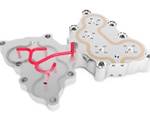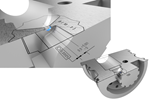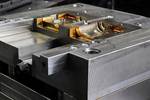
This mold component for plastic bottles (gate insert) was made by bonding three split parts. The channels inside the component cool the molded products efficiently. The products passed a 72-hour leak test. Source (All Images) | Punch Industry USA Inc.
A bonding and sintering technology for manufacturing mold and die components addresses challenges inherent in traditional 3D printing methods. Here are six key aspects of this technology to consider that can enhance efficiency, expand material choices and ensure the reliability of the end product:
1. Metal bonding/sintering: This process uses heat and pressure for metal bonding, resulting in joint strength exceeding 90% of the base material. This robust bonding mechanism ensures the durability and reliability of the manufactured components. Additionally, the bonded metals can undergo annealing, enabling them to be machined as usual, providing flexibility in post-bonding processes.
2. Material compatibility and surface quality: The technology distinguishes itself by its ability to bond to almost all iron-based materials, expanding the range of material choices for manufacturers. It also addresses the issue of rough surfaces on cooling channels, commonly observed in metal 3D printed products. The cooling channels inside these products exhibit a finer surface compared to 3D printed channels, enhancing overall surface quality.
3. Surface coating innovation: A patent-pending rust-preventive surface treatment is a notable feature of this technology. Applied to the cooling channels before bonding, this surface coating significantly reduces the formation of rust, ensuring a smooth production process and contributing to cost reduction. The technology also incorporates heat-resistant coatings to withstand the high temperatures (approximately 1000℃) applied during the bonding of split parts.

This core pin for a die-cast die tool was made by placing a spiral-grooved part inside the cylinder and integrating spiral cooling channels.
4. Ordering process and development phase: Customers can seamlessly engage with the technology through a structured ordering process. After designing a component with cooling channels, customers receive expert suggestions on splitting the component. Upon approval of the split parts, a detailed quotation is prepared and submitted. During the development phase, joint strength is rigorously measured through bending tests on both bonded and unbonded materials.
5. Bonding conditions: This technology involves a specifically developed bonding condition for various iron-based materials, including SKD11, SKD61, Stavax and Elmax. The bonding process ensures a minimum strength of 90% of the base material. The size of materials that can be bonded depends on the machine used, with optimal dimensions recommended for efficient bonding.
6. Quality assurance measures: To ensure product integrity, products undergo leak tests, subjecting them to water pressure for 24 hours. A jig is employed for this purpose, and the cost of fabricating the jig is transparently communicated to the customer.
Related Content
-
The Lowdown on Guided Ejection Systems
Learn more about guided ejection systems in terms of when, where, how and why to use them to benefit you as the moldmaker. Use this guide to better understand best practices associated with guided ejection systems.
-
Fundamentals of Designing the Optimal Cooling System
The right mold components can help improve mold cooling and thereby produce higher-quality parts.
-
A 3D Printing Retrospective
A personal review of the evolution of 3D printing in moldmaking throughout the past 25 years.















